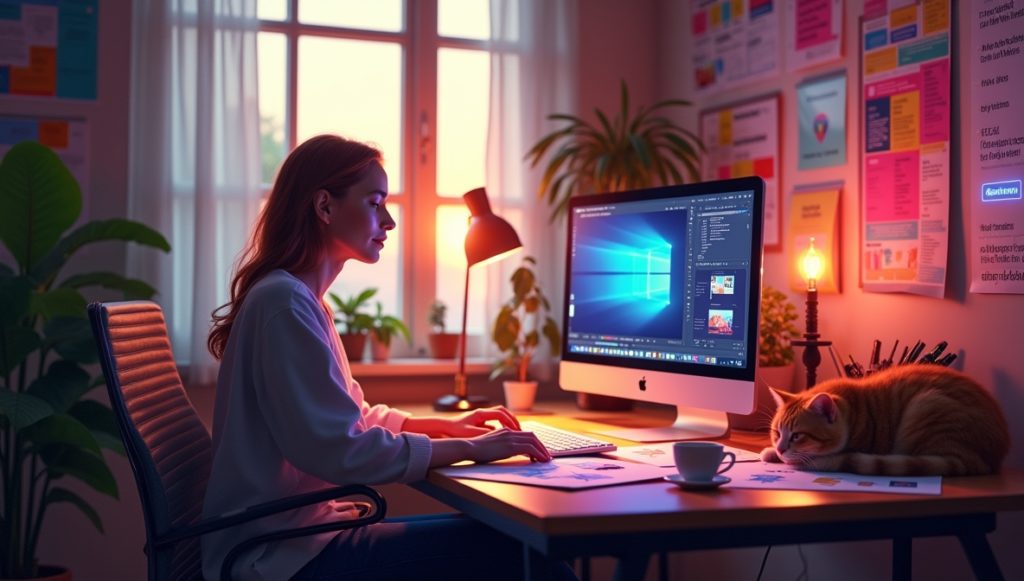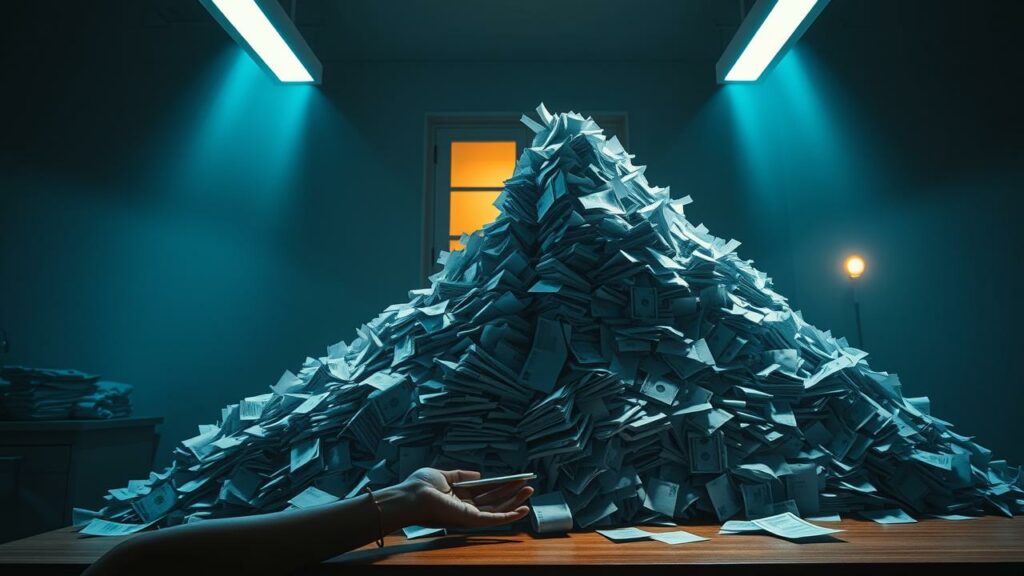Is the glow of your monitor the only window you have? Feeling creatively capped by corporate beige and endless meetings? Maybe you’re just ready to design your life, not just logos?
If you’re nodding along, the world of remote freelance graphic design might be calling your name. And it’s not just a daydream – designers are building fulfilling, flexible careers outside the traditional office walls. We’re talking potentially earning anywhere from $20 to $150 per hour, crafting visuals for clients you actually vibe with, all while wearing fuzzy slippers (or not, your call).
Quick Peek: What’s Inside This Guide
- Why Ditching the Cubicle Might Be Your Best Move Yet
- What Skills REALLY Matter in 2025? (Hint: It’s Not Just Photoshop)
- Your Portfolio: More Than Just Pretty Pictures
- Where the Heck Do You Find These Remote Gigs?
- Let’s Get Real: The Not-So-Glamorous Side
- Peeking into the Crystal Ball: Design Trends for 2025 (Hello, AI)
- Still Got Questions? Quick Answers Here
- Okay, What Now? Your First Steps
Why Ditching the Cubicle Might Be Your Best Move Yet
The allure is strong. Freedom. Flexibility. The chance to work on diverse projects. It’s not just you feeling it – remote work is booming. In fact, some reports saw a notable jump in remote job postings last year, showing this isn’t just a blip.
Think about Elena. She was stuck in a marketing role, feeling the rigid corporate structure draining her creative soul. She craved autonomy. So, she took the leap. Starting with passion projects to build her confidence and portfolio, she eventually carved out a niche doing branding for startups she genuinely believed in. It took work, sure, but now she sets her own hours and rates ($75/hr, not bad!).
And it seems Elena’s not alone in feeling better off. One survey found a whopping 69% of remotely working designers report greater job satisfaction compared to their pre-pandemic days. More control, less commute, more focus time – what’s not to like?
What Skills REALLY Matter in 2025? (Hint: It’s Not Just Photoshop)
Okay, so you’re sold on the ‘why’. Now, the ‘how’. What skills actually land you those coveted remote freelance graphic design jobs?
Yes, your core design chops – typography, color theory, layout – are non-negotiable. Mastery of industry-standard tools like Adobe Creative Suite (Photoshop, Illustrator, InDesign) is assumed. But the game is evolving.
- UI/UX Savvy: Designing for screens is huge. Understanding user experience (UX) and user interface (UI) principles is increasingly valuable. Familiarity with tools like Figma or Sketch is often essential.
- Motion Graphics & Video: Static images aren’t always enough. Basic animation or video editing skills can make your work pop and meet client demands for engaging content.
- AI Fluency (Yes, Really): Artificial intelligence isn’t here to replace you (let’s hope!), but to augment you. Knowing how to ethically and effectively use AI design tools for brainstorming, mockups, or even generating assets is quickly becoming a key differentiator. Roughly 75% of creative teams already see AI tools as essential.
- Soft Skills FTW: Communication, time management, project management, client negotiation – these are CRITICAL when you’re your own boss. Can you clearly articulate your ideas via email or video call? Can you manage deadlines without someone breathing down your neck?
“The graphic design landscape in 2025 is dynamic. Staying informed about the latest trends and continuously updating skills ensures competitiveness and impact.”
Staney’s right. Complacency is the enemy. Continuous learning isn’t just nice; it’s necessary.
Your Portfolio: More Than Just Pretty Pictures
Forget your resume for a second. In the design world, your portfolio is your handshake, your interview, and your closing argument, all rolled into one. Research suggests a huge majority (think 80%) of hiring managers lean heavily on portfolios before even thinking about contacting a designer.
It needs to be killer. But what does that mean?
- Quality over Quantity: Show your best work, not all your work. 5-10 stellar, well-presented projects are better than 30 mediocre ones.
- Show the Process: Don’t just show the final shiny thing. Briefly explain the client’s problem, your thought process, the challenges, and how your design solved it. This shows strategic thinking.
- Tailor It (If Possible): If you’re applying for a specific type of role (e.g., UI design), highlight relevant projects first.
- Make it Accessible: Have a clean, easy-to-navigate online portfolio website (Behance, Dribbble, your own site). Ensure it looks great on mobile.
- Show Your Niche (or Potential): Specializing can command higher rates. If you have a niche (like Elena’s startup branding), showcase it. If you’re exploring, show projects demonstrating skills in emerging areas.
Consider Priya. She’s a talented designer from India but initially found it tough to compete for global projects. Her solution? She didn’t just polish her existing portfolio; she actively upskilled in motion graphics and even dabbled in AR/VR filters through online courses. By adding these in-demand skills and showcasing them effectively, she started landing remote projects with major international brands.
“A well-crafted portfolio is crucial. It’s often the determining factor in a client’s decision to hire.”
Need inspiration on showcasing your work? Austin Kleon’s book “Show Your Work!” is a fantastic, quick read about generously sharing your process.
Where the Heck Do You Find These Remote Gigs?
Alright, you’ve got the skills, the portfolio is gleaming. Now, where do you actually find remote graphic design work?
- Specialized Job Boards: Think beyond Indeed. Look at boards focused on remote work (like We Work Remotely, FlexJobs) or creative industries (like Dribbble Jobs, Behance Jobs, Authentic Jobs).
- Freelance Marketplaces: Platforms like Upwork and Fiverr can be starting points, but be aware of high competition and potentially lower rates initially. Use them strategically. Toptal vets freelancers rigorously but offers higher-paying gigs.
- Niche Platforms: Depending on your specialty (e.g., logo design, web design), niche platforms might exist.
- Networking (Online & IRL): Connect with other designers, potential clients, and industry folks on LinkedIn, Twitter (X), Instagram, or niche communities. Attend virtual (or even local) meetups. Referrals are golden.
- Direct Outreach: Identify companies or brands you admire and see if they hire freelancers. A polite, personalized inquiry showcasing how you can help them can sometimes work wonders.
It often takes a mix of strategies. Don’t just rely on one source. Keep your eyes open and be persistent.
Let’s Get Real: The Not-So-Glamorous Side
Working remotely in your PJs sounds dreamy, but let’s be honest, freelance life isn’t always sunshine and perfectly kerned typography. There are challenges:
- Isolation: You miss the water cooler chat? Sometimes. Working alone can be isolating. Actively build connections online or join coworking spaces occasionally.
- Feast or Famine Cycle: Income can be irregular, especially at first. Financial planning and building a client base take time.
- Wearing All the Hats: You’re the designer, salesperson, accountant, project manager, and IT support. Be prepared to juggle.
- Competition: The remote world opens up global competition. Standing out requires constant effort and skill development (remember Priya?).
- Burnout Risk: Without clear boundaries, work can bleed into life. This happened to Rashid. He was a talented in-house designer but got totally fried by constant demands. Leaving his job, he intentionally built his freelance UX/UI practice with structure, using tools like Asana and Miro to manage projects and client communication efficiently. He learned the hard way that setting boundaries is crucial for sustainable freelancing.
Recognizing these challenges upfront helps you prepare for them, rather than getting blindsided.
Peeking into the Crystal Ball: Design Trends for 2025 (Hello, AI)
The design world never sits still. Staying ahead means keeping an eye on trends impacting remote freelance graphic design jobs right now, in 2025:
- AI Integration is Real: As mentioned, AI tools are becoming standard. Learning to leverage them for efficiency and creativity is key. This includes understanding ethical considerations around image generation and copyright.
- Focus on Sustainability & Accessibility: Clients increasingly want designs that are not only beautiful but also inclusive (WCAG accessible) and environmentally mindful (e.g., optimizing web graphics for lower energy consumption).
- Demand for Interactive & Immersive Experiences: Think motion graphics, microinteractions, maybe even AR/VR elements for certain projects. Static is still essential, but dynamic content is growing.
- Personalization & Authenticity: Stock-standard looks are out. Clients want unique brand identities that connect genuinely with their audience. Your unique style and perspective are assets.
- Continued Remote Collaboration: Tools like Figma, Miro, Slack, and Asana aren’t just nice-to-haves; they’re essential for seamless remote teamwork with clients globally.
While the overall outlook for graphic designers remains relatively stable according to sources like the U.S. Bureau of Labor Statistics, competition is fierce. Adapting to these trends is how you’ll stand out.
Still Got Questions? Quick Answers Here
How much can I actually earn freelancing?
It varies wildly based on experience, skills, niche, location, and clients. Global rates often fall between $20-$150 per hour. Beginners might start lower, while specialists command top dollar. Don’t undersell yourself, but be realistic as you build experience.
What are the best online platforms for graphic designers?
For showcasing work, Behance and Dribbble are popular. For finding jobs, check remote-specific boards (We Work Remotely, FlexJobs), creative boards (Dribbble Jobs), and marketplaces (Upwork, Fiverr – use strategically), or consider higher-tier curated platforms if you qualify (Toptal).
Is a portfolio really that important?
YES. Emphatically yes. It’s typically the single most important factor for clients deciding whether to contact you. Make it shine!
How do I even start freelancing if I have no experience?
Build a portfolio first! Offer to do pro-bono work for non-profits you care about, create self-initiated “passion projects,” redesign existing brands (clearly labeling it as a concept), or help out friends/family to get initial pieces. Then, leverage that portfolio on platforms and through networking.
Okay, What Now? Your First Steps
Feeling fired up? Maybe a little overwhelmed? Totally normal. Landing great remote freelance graphic design jobs is a marathon, not a sprint. Here’s what you can focus on now:
- Polish That Portfolio: Seriously. Review it with a critical eye. Does it showcase your best, most relevant work? Does it tell a story? Make this your top priority. Remember Austin Kleon: Show Your Work!
- Identify One Skill to Learn/Improve: Inspired by Priya? Choose one area – maybe basic motion graphics, Figma prototyping, or even just getting comfortable with an AI image generator – and dedicate some time to learning it this month.
- Explore ONE Platform or Job Board: Don’t try to be everywhere at once. Pick one platform (like Behance Jobs or a niche remote board) and really explore it. See what kinds of jobs are posted, what skills are requested.
- Connect with One Other Designer: Find someone whose freelance career you admire online (LinkedIn, Dribbble, etc.). Reach out, compliment their work, ask a thoughtful question. Start building your network.
Pick just one of these. Small, consistent steps build momentum. You don’t have to overhaul your life overnight.
The world of remote freelance graphic design is full of opportunity for talented, driven designers like you. It takes effort, adaptability, and a bit of business savvy, but the payoff – freedom, flexibility, and fulfilling work – can be immense. You’ve got this.







